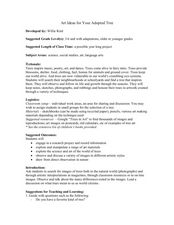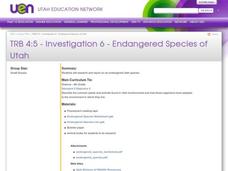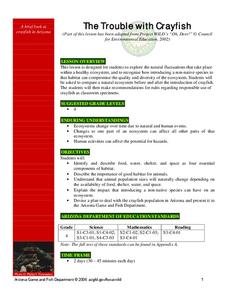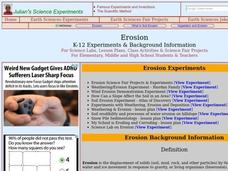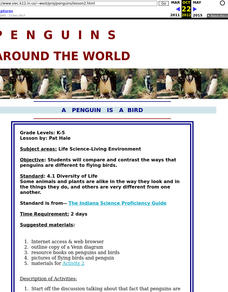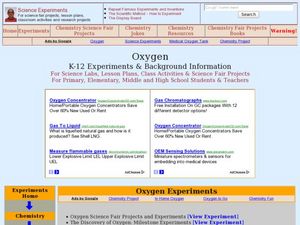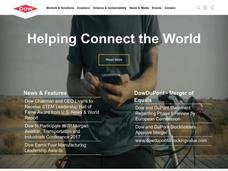Curated OER
Onion Skins
Students explore the structure of a plant cell. They carefully peel a single layer of onion skin from a slice of onion and stain it with methylene blue to observe the structures inside. They use a Digiscope connected to a computer to...
Curated OER
Who's Coming to Lunch: A Study of Mold Growth
Students participate in an experiment to determine where fungi and molds are formed, and create graphs documenting fungal growth.
Curated OER
Your Own Fresh Water Aquarium in the Classroom
Students explore aquariums. In this fish and ecosystems lessons, students establish a freshwater aquarium environment using materials provided. Students read about and care for the classroom fish.
Curated OER
Root, Root, Root for the Nutrients
Young scholars observe the growth of a seed, predict what will happen when seeds are planted without soil, and conduct an experiment using a hydroponics system.
Curated OER
One Kid Can Make A Difference
Students make a pledge to make three positive choices for 30 days and track their progress. In this positive choices lesson plan, students discuss ways in which they can be healthier, protect the environment, be respectful, and more....
Curated OER
Art Ideas for Your Adopted Tree
Students honor an adopted tree with artwork. In this adopted tree instructional activity, students find a tree in their neighborhood. They follow the tree throughout the year, keep notes, draw sketches, take photos and rubbings. They...
Curated OER
Investigation 7 - Plants In Soil
Fourth graders explain how the components of soil effect plant growth. They brainstorm different kinds of materials that plants could use for structural support. They design an experiment to show that plants can grow without soil.
Curated OER
The Trouble with Crayfish
Fourth graders compare an ecosystem before and after they introduce crayfish to that ecosystem. In this ecosystem lesson plan, 4th graders see what happens when you introduce a non native animal to a habitat. Students then make...
Curated OER
Discovering Owls
Pupils are introduced to different types of owls and owl pellets. They list several adaptations that benefit the owls. Students identify the various species of owl that live in Wisconsin. Pupils discuss owl pellets and identify the...
Curated OER
Adaptations
Students identify what adaptation is and to research a specific mollusk. They also identify and interpret how animals get their common and scientific name and why it is Latin. Finally, students draw their shell (mollusk) and name their...
Curated OER
Growing Tomatoes from Seed
In this growing tomatoes worksheet, pupils experience and participate in the process of growing tomatoes over a three or four month span of time. Students follow six directives in producing tomato plants.
Curated OER
Growing Tomatoes From Seed Activity
For this growing tomatoes worksheet, students plant tomato seeds in February, and follow their growth through the summer break. They observe and investigate the plant growth from seed to plant.
Curated OER
Cranes, Crosswalks, and Big Gulps
Learners watch a video and answer questions based on wildlife jobs. In this wildlife lesson plan, students learn that biologists don't just play with animals but that there is a lot of study involved.
Curated OER
Cooking Lesson
Fourth graders taste different flavors on their popcorn. In this taste bud instructional activity, 4th graders make predictions about taste and dip popcorn into four different flavors. They record how the flavors tasted - sweet, salty,...
Curated OER
Erosion
Young scholars examine soil erosion and what causes it. In this soil lesson students complete several experiments on soil erosion and the weathering process.
Curated OER
A Penguin is a Bird
Students compare and contrast the ways that penguins are different to flying birds.
Curated OER
Bats, Bats, Everywhere!
Students research information on bats while working in cooperative groups. They design posters with the information from their research.
Curated OER
Bivalve or Univalve (Clam or Snail)?
Fourth graders explore the meaning of the prefixes "bi" and "uni." In groups, 4th graders observe pictures of shells and handle real shells. Students create a chart to classify each shell as a bivalve or univalve. They identify the...
Curated OER
Oxygen
Young scholars explore oxygen and its physical and chemical propeties. In this investigative lesson students complete several experiments using oxygen.
Curated OER
Fossil Fuels vs. Alternative Fueling Systems
Fourth graders brainstorm the differences between the fossil fuels that people use in their transportation now and what they could use to minimize greenhouse gas emissions. They use a variety of techniques from webquests to writing...
Curated OER
Wetland Adaptation
Fourth graders study the impact of the wetland environment on the migration of birds. They make a list of the important reasons on a large piece of paper to be posted in the classroom and point out the biggest wetland in the state (The...
Curated OER
Coal Flowers
Students create coal flowers. In this mining lesson, students discuss the importance of coal during the 1800s and use ingredients to make coal flowers. Students determine the effect temperature has on crystal formation.
Curated OER
Is There A Fungus Among Us?
Students experiment with fungi and yeast in order to determine their role in nature. Students study terms associated with fungi and yeast through this series of lessons.
Other popular searches
- Science Project Food Apples
- Science Project Food Chain
- Science Project Food Waste
- Science Project Food Rice
- Food Science Fair Projects
- Science Project Food Decay
- Science Projects Food Chain







